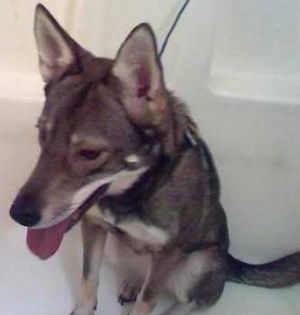Coyote-dog Hybrids
Canis latrans × Canis familiaris
Mammalian Hybrids
EUGENE M. MCCARTHY, PHD GENETICS, ΦΒΚ
|
It is by no means uncommon to find mongrel dogs among many of the western Indian tribes, notably among Umatillas, Bannocks, Shoshones, Arrapahoes, Crows and Sioux, which, to one familiar with the color, physiognomy and habits of the coyote, have every appearance of blood relationship, if not, in many cases, this animal itself in a state of semi-domestication.
—Jacob L. Wortman,
Post-pliocene Vertebrates of Indiana (1884, p. 8) |
 A coydog (Coyote × German Shepherd) Image: Wikimedia, Lyta79
A coydog (Coyote × German Shepherd) Image: Wikimedia, Lyta79
Coyote-dog hybrids are known as coydogs. This cross is reversible, but it usually involves a male dog, given that any male dog can fertilize a female coyote in heat. To fertilize a bitch in heat, a male coyote must be in rut.
As to natural hybridization, coydogs occur widely in North America and are relatively common. For example, a single hunter killed 25 coyote-dog hybrids in Kansas between 1945 and 1951 (Gier 1957, p. 45). Recently, coyotes even managed to colonize Long Island and interbred with dogs there (Nagy et al. 2017).
Adams et al. (2003) report that dog mtDNA haplotypes are widespread in southeastern coyote populations, which shows that female dogs do cross with male coyotes. However, a study conducted by Wheeldon et al. (2013) found that many male coyotes in eastern populations have dog-like Y chromosomes, which suggests that the cross occurs more often in the opposite direction, probably due to the rut constraint mentioned above. Evaluation of the question with SNPs revealed the same bias (Monzón et al. 2013), that is, the direction of the cross is usually male dog × female coyote.
Regarding a population, thamnos, in Minnesota, treated as a race of the coyote, and a highly variable hybrid population in New England, Lawrence and Bossert (1969, p. 8) say that “thamnos is intermediate between latrans and the New England population and while it overlaps strongly with
Coyote-dog hybrids are partially fertile in both sexes, that is, while they are generally not as fertile as either pure dogs or coyotes, coydogs of both sexes have produced offspring.
Coydogs howl like coyotes but also bark like dogs. This phenomenon of combining the two parents’ voices occurs in a wide variety of mammalian crosses, for example, the songs of hybrids between the White-handed Gibbon and Pileated Gibbon combine characteristics of the songs of both their parents.
Mengel says the second-generation hybrids that he evaluated were more varied than were hybrids of the first generation (mongrel C. familiaris female × C. latrans male) and composed of “doglike to somewhat coyote like animals. Behavior varied, but all of the animals were intermediate, with some coyote-like traits, including howling…their small number [mean = 2.25 pups; range 1 to 3] in relation to the possible number, suggests some decrease in fecundity but might also have resulted from crowding or other sub-optimal conditions inducing prenatal mortality. There was a rather high incidence of dental anomaly.”
Mengel and others (Gier 1957, pp. 46-47; Kennelly and Roberts 1969; Silver and Silver 1969, pp. 31-32) have reported that coy-dog hybrids breed earlier (December) than pure coyotes (February). Coyote testes usually begin to regress in March and by June no spermatozoa are present. Gipson et al. (1975) say male hybrids are seasonal breeders like the coyote, but their cycle begins two months earlier than a coyote’s and may peak after male coyotes.
Hybridization of this type has been known since at least the 1880s (Seton 1929, p. 401; Shufeldt 1887). Shufeldt (1887) says coydogs that he observed “run and trot like the coyote; and when off at a distance they have a way of standing sidewise as motionless as a statue and regarding you; while at such times they keep their two fore-limbs together, as well as the hinder ones. Such a position is very commonly assumed by the prairie-wolf [i.e., the coyote], and may be said to be a direct lateral view of the animal, with its face looking towards you.”
Note: Mengel (p. 324) mentions an F₁ male coyote-dog hybrid with asymmetric teeth (C though M2 much longer on left side).
References: Adams et al. 2003; Bee and Hall 1951; Bekoff 1977; Carson 1962; Cook 1952; Dice 1942; Gier 1957; Gipson et al. 1974, 1975; Hall 1943a; Hilton 1978; Kennelly and Roberts 1969; Kolenosky 1971; Lawrence and Bossert 1969; McCarley 1959; Mahan 1977; Mahan and Gipson 1978; Mengel 1971†; Murie 1936; Richens and Hugie 1974; Riley and McBride 1975; Seton 1929; Shufeldt 1887; Silver and Silver 1969; Young and Jackson 1951 (pp. 121-124).
By the same author: Handbook of Avian Hybrids of the World, Oxford University Press (2006).
A list of dog crosses
The following is a list of reported dog crosses discussed on this site. Some of these crosses are much better documented than others (as indicated by the reliability arrow). Moreover, some are extremely disparate, and so must be taken with a large grain of salt. But all have been reported at least once.
|
|
Most shared on Macroevolution.net:
Human Origins: Are we hybrids?
On the Origins of New Forms of Life
Mammalian Hybrids
Cat-rabbit Hybrids: Fact or fiction?
Famous Biologists
Dog-cow Hybrids
Prothero: A Rebuttal
Branches of Biology
Dog-fox Hybrids
 Source:
Source: